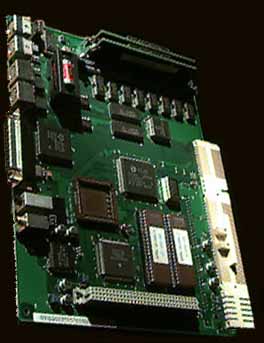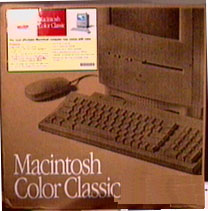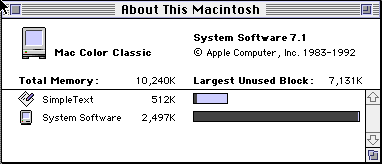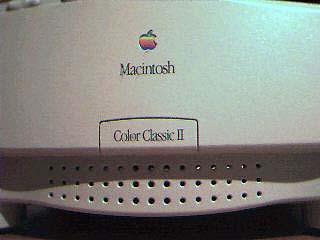| Macintosh Color Classic | ||||||||||||||||||||||||||||
| Specifically the Color Classic (Performa 250) / Color Classic II (Performa 275) | ||||||||||||||||||||||||||||
| The successor to all classic Macintoshes • Color! • Speed! • Compact! • Cool! |
This page is my tribute to the classic Mac I like the best. It shaped the world as it was the first color Mac which had the footprint of the original Macintosh.
Is it Color or Colour? If you call this Macintosh a Color Classic or a Colour Classic is does not matter. This Mac perfers both names. |
|||||||||||||||||||||||||||
|
|
||||||||||||||||||||||||||||
|
|
||||||||||||||||||||||||||||
| Color Classic Manuals -
Apple moved the links again. Once I find them i will relink the following:
|
||||||||||||||||||||||||||||
|
||||||||||||||||||||||||||||
| The Color Classic | ||||||||||||||||||||||||||||
| At the time the Color Classic came out, its speed was not bad at all! Some sites refer to it as a Road Apple, I think not. At the time the Color Classic came out, that was the way you designed a computer. The first Macintosh had a 16/24 bit CPU on a 16-bit bus. So the 32-bit CPU on a 16-bit bus was normal. Many other Macs came out with a matching CPU and bus bit width, however those Macs were more expensive (by several thousand). The main reason the Color Classic came out was a classic form-factor color computer at an inexpensive price. $1,390 was a cheap computer back in 1993. Today the first iMac debuted at $90 less with a cool speedy processor (233Mhz). Normal. | ||||||||||||||||||||||||||||
 |
 |
|||||||||||||||||||||||||||
| A good picture of the Color Classic | The motherboard of the Color Classic with max RAM, no FPU (empty brown socket) and no card. | |||||||||||||||||||||||||||
| The Mac Color Classic (aka Performa 250) was not a bad computer. The only real cousin to it was the Macintosh Classic II, they had the same CPU and bus design. I would trade in a bit of performance for color in a classic design! Alas the Classic II is a bit faster, driving only a black & white screen.The case on the Color Classic is a taller one, with predominant feet. I like the look of it, any case design changes were necessary to give you the power it has. | ||||||||||||||||||||||||||||
| The best feature was the ease of expandability for the user. The motherboard popped out of the rear and adding memory, video memory or expansion card was simple. No more opening the case to upgrade the parts you really need. The only real hard upgrade is the hard drive (yes the case had to come off for this). With external drive options hooked to the SCSI port, this was not a big deal. The microphone is located in the top of the unit, it does pick up computer noises so for voice annotations it works great (where some background noise is ok). For professionally recorded sounds, get an external microphone. | ||||||||||||||||||||||||||||
 |
The box the Color Classic originally shipped in << | |||||||||||||||||||||||||||
|
A close up of the name on the unit >>
|
||||||||||||||||||||||||||||
| After using a Color Classic, I like the screen. Applications are mainly written for 640 x 480, so the bottom is cut off and not displayed. This would not be a good choice for running older games. Application software is fine, many business applications have a magnification level to adjust how much you can see in the active window. | ||||||||||||||||||||||||||||
 |
||||||||||||||||||||||||||||
| The about box from a Color Classic. As the max RAM is 10MB the System takes almost 3MB of it. Remember the Color Classic II has a limit of 36MB of RAM. |
||||||||||||||||||||||||||||
|
|
||||||||||||||||||||||||||||
| The Color Classic II | ||||||||||||||||||||||||||||
|
|
||||||||||||||||||||||||||||
| This baby has speed. The Color Classic II (aka Performa 275) has the logic board which will make the original Color Classic shine! The Color Classic II is the true successor to the Macintosh SE/30 in every way. Don't get me wrong, I use and like most of the later classic Macs after the SE/30, however everyone will agree that this is the fastest of all of the Classic form-factor.
It is not 100% clear is the Color Classic II debuted in the Canada market or the Asia market first. I have heard both stories. |
||||||||||||||||||||||||||||
 |
||||||||||||||||||||||||||||
| The 33/33 CPU/data bus combination provided a different way to design computers. The closer the CPU and the data bus travels together, the more expensive the computer will be, besides the performance gain.
I am not sure the exact price this one came out at, as it was only available in Asia and Australia. I have heard many people in Australia who have Color Classic IIs, it does not really matter if they were available locally to them. They were lucky to get their hands on them more readily them us in the United States. I am fortunate to own one. |
||||||||||||||||||||||||||||
| One difference is the name plate on the case. | ||||||||||||||||||||||||||||